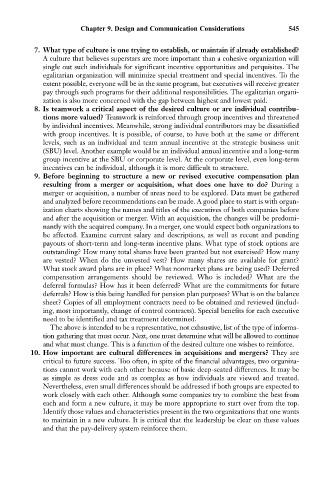Page 559 - Bruce Ellig - The Complete Guide to Executive Compensation (2007)
P. 559
Chapter 9. Design and Communication Considerations 545
7. What type of culture is one trying to establish, or maintain if already established?
A culture that believes superstars are more important than a cohesive organization will
single out such individuals for significant incentive opportunities and perquisites. The
egalitarian organization will minimize special treatment and special incentives. To the
extent possible, everyone will be in the same program, but executives will receive greater
pay through such programs for their additional responsibilities. The egalitarian organi-
zation is also more concerned with the gap between highest and lowest paid.
8. Is teamwork a critical aspect of the desired culture or are individual contribu-
tions more valued? Teamwork is reinforced through group incentives and threatened
by individual incentives. Meanwhile, strong individual contributors may be dissatisfied
with group incentives. It is possible, of course, to have both at the same or different
levels, such as an individual and team annual incentive at the strategic business unit
(SBU) level. Another example would be an individual annual incentive and a long-term
group incentive at the SBU or corporate level. At the corporate level, even long-term
incentives can be individual, although it is more difficult to structure.
9. Before beginning to structure a new or revised executive compensation plan
resulting from a merger or acquisition, what does one have to do? During a
merger or acquisition, a number of areas need to be explored. Data must be gathered
and analyzed before recommendations can be made. A good place to start is with organ-
ization charts showing the names and titles of the executives of both companies before
and after the acquisition or merger. With an acquisition, the changes will be predomi-
nantly with the acquired company. In a merger, one would expect both organizations to
be affected. Examine current salary and descriptions, as well as recent and pending
payouts of short-term and long-term incentive plans. What type of stock options are
outstanding? How many total shares have been granted but not exercised? How many
are vested? When do the unvested vest? How many shares are available for grant?
What stock award plans are in place? What nonmarket plans are being used? Deferred
compensation arrangements should be reviewed. Who is included? What are the
deferral formulas? How has it been deferred? What are the commitments for future
deferrals? How is this being handled for pension plan purposes? What is on the balance
sheet? Copies of all employment contracts need to be obtained and reviewed (includ-
ing, most importantly, change of control contracts). Special benefits for each executive
need to be identified and tax treatment determined.
The above is intended to be a representative, not exhaustive, list of the type of informa-
tion gathering that must occur. Next, one must determine what will be allowed to continue
and what must change. This is a function of the desired culture one wishes to reinforce.
10. How important are cultural differences in acquisitions and mergers? They are
critical to future success. Too often, in spite of the financial advantages, two organiza-
tions cannot work with each other because of basic deep-seated differences. It may be
as simple as dress code and as complex as how individuals are viewed and treated.
Nevertheless, even small differences should be addressed if both groups are expected to
work closely with each other. Although some companies try to combine the best from
each and form a new culture, it may be more appropriate to start over from the top.
Identify those values and characteristics present in the two organizations that one wants
to maintain in a new culture. It is critical that the leadership be clear on these values
and that the pay-delivery system reinforce them.

